MacDon 4000 User Manual
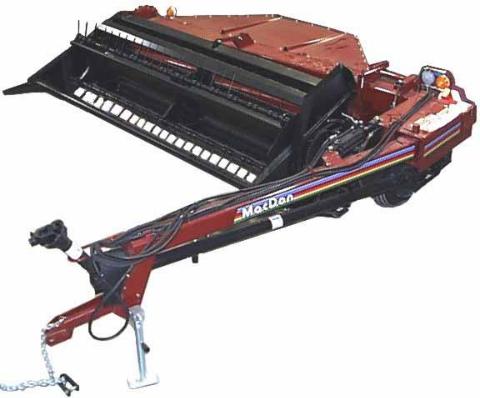
INTRODUCTION
Your new MacDon Model 4000 Mower Conditioner is designed to cut, condition and lay in windrows, a wide variety of grasses and hay crops.
Use this manual as your first source of information about the machine. If you follow the instructions given in this manual, your Mower Conditioner will work well for many years.
The manual contains instructions for "Safety", "Operation", and "Maintenance/Service". In addition, "Unloading and Assembly" information is given towards the back of this book.
CAREFULLY READ ALL THE MATERIAL PROVIDED BEFORE ATTEMPTING TO UNLOAD, ASSEMBLE, OR USE THE MACHINE.
Use the Table of Contents and the Index to guide you to specific areas. Study the Table of Contents to familiarize yourself with how the material is organised.
Keep this manual handy for frequent reference and to pass on to new operators or owners. Call your Dealer if you need assistance, information, or additional copies of this manual.
NOTE: Right hand (R/H) and left hand (L/H) designations are determined from the operator’s position, facing forward.
1
TABLE OF CONTENTS |
|
|
PAGE |
INTRODUCTION ..................................................................................................................................... |
1 |
SERIAL NUMBER LOCATION ................................................................................................................ |
4 |
SAFETY |
|
Safety Alert Symbol ....................................................................................................................... |
5 |
Signal Words ................................................................................................................................. |
5 |
Safety Signs................................................................................................................................... |
6 |
General Farm Safety .................................................................................................................. |
7,8 |
SPECIFICATIONS |
|
Mower Conditioner.................................................................................................................... |
9,10 |
Tractor Requirements.................................................................................................................. |
10 |
Torque Specifications ............................................................................................................. |
11,12 |
Bearing Installation ...................................................................................................................... |
12 |
OPERATION |
|
Your Responsibilities as an Owner/Operator............................................................................... |
13 |
To the New Operator ................................................................................................................... |
13 |
Preparing the Tractor................................................................................................................... |
14 |
Preparing the Mower Conditioner ................................................................................................ |
15 |
Attaching Mower Conditioner to Tractor ...................................................................................... |
16 |
Detaching Mower Conditioner from Tractor................................................................................. |
17 |
Break-In Period............................................................................................................................ |
18 |
Pre-Starting Checks: Annual ....................................................................................................... |
19 |
Pre-Starting Checks: Daily........................................................................................................... |
20 |
Operate Correctly ........................................................................................................................ |
21 |
Lift Cylinder Stop - Raising and Lowering the Machine ............................................................... |
22 |
Positioning the Hitch .................................................................................................................... |
23 |
Engaging the PTO ....................................................................................................................... |
24 |
Opening the Field ........................................................................................................................ |
24 |
Cutting Width ............................................................................................................................... |
24 |
Cornering ..................................................................................................................................... |
24 |
Operating Variables: |
|
Ground Speed................................................................................................................... |
25 |
Reel Speed........................................................................................................................ |
26 |
Reel Position ................................................................................................................ |
27,28 |
Cutting Height - Skid Plates .............................................................................................. |
28 |
Cutterbar Angle ................................................................................................................. |
29 |
Header Flotation................................................................................................................ |
30 |
Roll Gap ............................................................................................................................ |
31 |
Forming Shields ................................................................................................................ |
32 |
Light Crop Deflectors ..................................................................................................... |
32 |
Feed Pan Extensions ..................................................................................................... |
33 |
Haying Tips: |
|
Topsoil Moisture................................................................................................................ |
33 |
Climate and Topography................................................................................................... |
34 |
Swath / Windrow Characteristics ...................................................................................... |
34 |
Running Tractor Tire on Previously Cut Swath ................................................................. |
34 |
Raking and Tedding .......................................................................................................... |
34 |
Chemical Drying Agents.................................................................................................... |
34 |
Unplugging the Mower Conditioner: Knife ................................................................................... |
35 |
Unplugging the Mower Conditioner: Rolls ................................................................................... |
35 |
Shut-Down Procedure ................................................................................................................. |
36 |
Transporting the Mower Conditioner ........................................................................................... |
36 |
Storage Procedure....................................................................................................................... |
37 |
2
TABLE OF CONTENTS |
|
|
PAGE |
MAINTENANCE/SERVICE |
|
Service Procedures ..................................................................................................................... |
38 |
Recommended Lubricants........................................................................................................... |
39 |
Capacities of Enclosed Drives..................................................................................................... |
39 |
Greasing the Mower Conditioner .......................................................................................... |
40 - 43 |
Linkage Ball Joints....................................................................................................................... |
44 |
Hydraulics .................................................................................................................................... |
45 |
Electrical ...................................................................................................................................... |
45 |
Main Drive: |
|
Main Gearbox Lubricant.................................................................................................... |
46 |
Main Gearbox Removal .................................................................................................... |
46 |
Over-Running Clutch......................................................................................................... |
47 |
Knife and Knife Drive: |
|
Knife Lubrication................................................................................................................ |
48 |
Knife Sections ................................................................................................................... |
48 |
Knife Removal and Installation.......................................................................................... |
49 |
Knife Storage - ToolBox .................................................................................................... |
49 |
Guards .............................................................................................................................. |
50 |
Knife Clips ......................................................................................................................... |
50 |
Knife Drive Belt Tension.................................................................................................... |
51 |
Knife Drive Belt Replacement ........................................................................................... |
51 |
Wobble Box Mounting Bolts .............................................................................................. |
52 |
Wobble Box Lubricant....................................................................................................... |
52 |
Reel and Reel Drive: |
|
Reel Drive Belt Tension..................................................................................................... |
53 |
Reel Drive Belt Replacement ............................................................................................ |
53 |
Reel Drive Chain Lubricant ............................................................................................... |
54 |
Reel Drive Chain Tension ................................................................................................. |
54 |
Reel Tines ......................................................................................................................... |
54 |
Reel Shaft R/H Bearing Access ........................................................................................ |
54 |
Roll Timing................................................................................................................................... |
55 |
Wheels and Tires: |
|
Wheel Bolts ....................................................................................................................... |
56 |
Tire Inflation ...................................................................................................................... |
57 |
Maintenance Schedule ........................................................................................................... |
58,59 |
Maintenance Record.................................................................................................................... |
60 |
TROUBLE SHOOTING................................................................................................................... |
61 - 64 |
ATTACHMENTS: |
|
Four or Six Bat Reel .................................................................................................................... |
65 |
Stub Guard Conversion Kit .......................................................................................................... |
65 |
UNLOADING AND ASSEMBLY...................................................................................................... |
66 - 70 |
INDEX ..................................................................................................................................... |
71,72 |
3
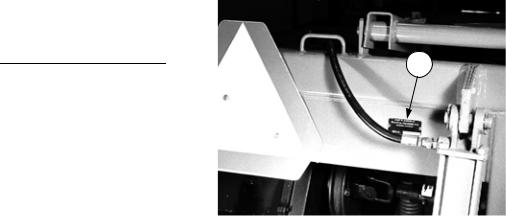
SERIAL NUMBER LOCATION
Record the serial number in the space provided.
Mower Conditioner:
A
Serial number plate (A) is located on the back of the drives frame.
NOTE: When ordering parts and service, be sure to give your dealer the complete and proper serial number.
SERIAL PLATE LOCATION
4

SAFETY
SAFETY ALERT SYMBOL
This safety alert symbol indicates important safety messages in this manual and on safety signs on the mower conditioner.
This symbol means:
ATTENTION !
BECOME ALERT !
YOUR SAFETY IS INVOLVED !
Carefully read and follow the safety message accompanying this symbol.
Why is SAFETY important to you?
3 BIG REASONS
•ACCIDENTS DISABLE AND KILL
•ACCIDENTS COST
•ACCIDENTS CAN BE AVOIDED
SIGNAL WORDS
Note the use of the signal words DANGER, WARNING, and CAUTION with safety messages. The appropriate signal word for each message has been selected using the following guidelines:
DANGER – Indicates an imminently hazardous situation that, if not avoided, will result in death or serious injury.
WARNING – Indicates a potentially hazardous situation that, if not avoided, could result in death or serious injury. It is also used to alert against unsafe practices.
CAUTION – Indicates a potentially hazardous situation that, if not avoided, may result in minor or moderate injury. It is also used as a reminder of good safety practices.
5
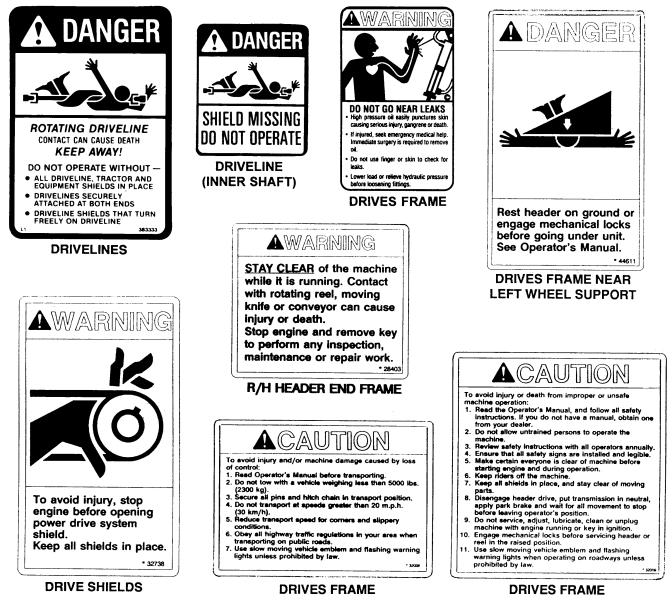
SAFETY
SAFETY SIGNS
•The safety signs reproduced below appear on the windrower at the locations listed.
•Keep safety signs clean and legible at all times
•Replace safety signs that are missing or become illegible.
•If original parts on which a safety sign was installed are replaced, be sure the repair part also bears the current safety sign.
•Safety signs are available from your Dealer Parts Department.
To install safety signs:
1.Be sure the installation area is clean and dry.
2.Decide on the exact location before you remove the decal backing paper.
3.Remove the smaller portion of the split backing paper.
4.Place the sign in position and slowly peel back the remaining paper, smoothing the sign as it is applied.
5.Small air pockets can be smoothed out or pricked with a pin.
6

SAFETY
GENERAL SAFETY
The following are general farm safety precautions that should be part of your operating procedure for all types of machinery.
1.Protect yourself.
When assembling, operating and servicing machinery wear all the protective clothing and personal safety devices that COULD be necessary for the job at hand. Don’t take chances.
You may need:
·a hard hat.
·protective shoes with slip resistant soles.
·protective glasses or goggles.
·heavy gloves.
·wet weather gear.
·respirator or filter mask.
·hearing protection. Be aware that prolonged exposure to loud noise can cause impairment or loss of hearing. Wearing a suitable hearing protective device such as earmuffs (A) or earplugs (B) protects against objectionable or loud noises.
2.Provide a first-aid kit for use in case of emergencies.
3.Keep a fire extinguisher on the machine. Be sure the extinguisher is properly maintained and be familiar with its proper use.
4.Keep young children away from machinery at all times.
5.Be aware that accidents often happen when the operator is tired or in a hurry to get finished. Take the time to consider the safest way. Never ignore warning signs of fatigue.
PROTECT YOURSELF
PROTECT AGAINST NOISE
BE PREPARED FOR EMERGENCIES
7

SAFETY
GENERAL SAFETY (continued)
6.Wear close-fitting clothing and cover long hair. Never wear dangling items such as scarves or bracelets.
7.Keep hands, feet, clothing and hair away from moving parts. Never attempt to clear obstructions or objects from a machine while the engine is running.
8.Keep all shields in place. Never alter or remove safety equipment. Make sure driveline guards can rotate independently of the shaft and can telescope freely.
9.Use only service and repair parts made or approved by the equipment manufacturer. Substituted parts may not meet strength, design, or safety requirements.
10.Do not modify the machine. Unauthorized modifications may impair the function and/or safety and affect machine life.
11.Stop engine and remove key from ignition before leaving operator’s seat for any reason. A child or even a pet could engage an idling machine.
12.Keep the area used for servicing machinery clean and dry. Wet or oily floors are slippery. Wet spots can be dangerous when working with electrical equipment. Be sure all electrical outlets and tools are properly grounded.
13.Use adequate light for the job at hand.
14.Keep machinery clean. Straw and chaff on a hot engine are a fire hazard. Do not allow oil or grease to accumulate on service platforms, ladders or controls. Clean machines before storage.
15.Never use gasoline, naphtha or any volatile material for cleaning purposes. These materials may be toxic and/or flammable.
16.When storing machinery, cover sharp or extending components to prevent injury from accidental contact.
NEVER WEAR LOOSE
OR DANGLING CLOTHES
KEEP AWAY FROM MOVING PARTS
KEEP SERVICE AREA CLEAN AND DRY
8
|
SPECIFICATIONS |
DIMENSIONS |
9 FT. MOWER CONDITIONER |
Overall Width: |
|
Transport Position |
147.5 in. (3750 mm) |
Field Position |
167.0 in. (4243 mm) |
Overall Length: |
|
Transport Position |
159.8 in. (4059 mm) |
Field Position |
166.8 in. (4238 mm) |
Overall Height: |
|
Transport Position |
59.5 in. (1510 mm) |
Field Position |
42.6 in. (1083 mm) |
Weight |
3318 lbs. (1505 kg) |
CUTTERBAR |
|
Cutterbar Width |
111 in. (2819 mm) |
Cutting Height (on skids) |
1 to 4 in. (25 to 100 mm) |
at 9° guard angle |
|
Guard Angle (adjustable) |
6° to 12° below horizontal |
HEADER |
|
Header Flotation |
-2.5 to +6.7 in. (-64 to +170 mm) |
Maximum Header Lift |
21.5 in. (545 mm) to guard tip |
KNIFE |
|
Drive Type |
Belt driven wobble box (enclosed oil bath) |
Speed |
1620 strokes or 810 cycles per minute |
Stroke |
3 in. (76 mm) |
Sections |
Over-serrated, low shoulder |
REEL |
|
Drive Type |
Belt primary to chain final |
Reel Type |
5 bats (4 or 6 bats optional), replaceable steel pick-up tines, |
|
cam action, polymer tine tube bearings |
Diameter |
42.5 in. (1080 mm) |
Tine Tip (Peripheral) Speed |
6.6, 7.0, 7.5 or 7.9 mph (10.6, 11.3, 12.0 or 12.7 km/h) |
Rotational Speed |
53, 56, 60 or 63 rpm |
Length |
104.3 in. (2650 mm) |
9
|
SPECIFICATIONS |
CONDITIONER ROLLS |
9 FT. MOWER CONDITIONER |
Drive Type |
Gear driven through telescoping u-joints |
Roll Type |
Helical intermeshing fabric reinforced rubber |
|
Or |
|
Helical intermeshing steel |
Roll Diameter |
Rubber: 9.5 in (242 mm) Steel: 10.0 in (254 mm) |
Roll Length |
105.8 in (2687 mm) |
Roll Speed |
729 rpm |
WHEELS |
|
Tread Width |
100 in (2540 mm) |
Tires |
9.5L – 14 I1 Rib Implement |
Tire Pressure |
20 psi (138 kPa) |
MATERIAL DISCHARGE |
|
Minimum Width |
33.3 in (845 mm) |
Maximum Width |
84.9 in (2156 mm) (wider in heavy crop) |
Number of Width Settings |
7 |
OPERATING SPEED |
|
Range |
up to 8 mph (13 Km/h) |
Recommended Speed for Most Conditions |
5 mph (8 Km/h) |
TRACTOR REQUIREMENTS |
|
Minimum Power |
35 hp (26 kW) |
Minimum Weight |
5000 lbs. (2268 kg) |
PTO |
540 rpm with ASAE Standard location |
Drawbar |
Clevis or straight, ASAE Standard hitch location |
Hydraulics: |
|
Type |
Two double acting remote circuits |
Minimum Pressure |
1350 psi (9300 kPa) |
(SPECIFICATIONS AND DESIGN ARE SUBJECT TO CHANGE WITHOUT NOTICE OR OBLIGATION TO REVISE UNITS PREVIOUSLY SOLD.)
10

TORQUE SPECIFICATIONS
CHECKING BOLT TORQUE
The tables shown below give correct torque values for various bolts and capscrews. Tighten all bolts to the torques specified in chart unless otherwise noted throughout this manual. Check tightness of bolts periodically, using bolt torque chart as a guide. Replace hardware with the same strength bolt.
ENGLISH TORQUE SPECIFICATION
Bolt |
|
NC Bolt Torque* |
|
||
SAE 5 |
|
SAE 8 |
|||
|
|||||
Dia. |
|
||||
"A" |
N·m |
[lb-ft] |
|
N·m |
[lb-ft] |
1/4" |
12 |
[9] |
|
15 |
[11] |
5/16" |
24 |
[18] |
|
34 |
[25] |
3/8" |
43 |
[32] |
|
56 |
[41] |
7/16" |
68 |
[50] |
|
95 |
[70] |
1/2" |
102 |
[75] |
|
142 |
[105] |
9/16" |
149 |
[110] |
|
202 |
[149] |
5/8" |
203 |
[150] |
|
271 |
[200] |
3/4" |
359 |
[265] |
|
495 |
[365] |
7/8" |
569 |
[420] |
|
813 |
[600] |
1" |
867 |
[640] |
|
1205 |
[890] |
|
|
|
|
|
|
METRIC TORQUE SPECIFICATIONS
|
|
|
|
|
|
|
|
|
|
|
Bolt |
|
|
|
|
Bolt Torque* |
|
|
|||
Dia. |
|
|
8.8 |
|
10.9 |
|||||
|
|
|
||||||||
"A" |
|
|
|
|||||||
|
N·m |
|
|
[lb-ft] |
|
|
N·m |
|
[lb-ft] |
|
|
|
|
|
|
|
|
||||
M3 |
0.5 |
|
[.4] |
|
1.8 |
[1.3] |
||||
M4 |
3 |
|
[2.2] |
|
4.5 |
[3.3] |
||||
M5 |
6 |
|
[4] |
|
9 |
[7] |
||||
M6 |
10 |
|
[7] |
|
15 |
[11] |
||||
M8 |
25 |
|
[18] |
|
35 |
[26] |
||||
M10 |
50 |
|
[37] |
|
70 |
[52] |
||||
M12 |
90 |
|
[66] |
|
125 |
[92] |
||||
M14 |
140 |
|
[103] |
|
200 |
[148] |
||||
M16 |
225 |
|
[166] |
|
310 |
[229] |
||||
M20 |
435 |
|
[321] |
|
610 |
[450] |
||||
M24 |
750 |
|
[553] |
|
1050 |
[774] |
||||
M30 |
1495 |
|
[1103] |
|
2100 |
[1550] |
||||
M36 |
2600 |
|
[1917] |
|
3675 |
[2710] |
||||
|
|
|
|
|
|
|
|
|
|
|
Torque figures indicated above are valid for non-greased or non-oiled threads and heads unless otherwise specified. Do not grease or oil bolts or capscrews unless specified in this manual. When using locking elements, increase torque values by 5%.
* Torque value for bolts and capscrews are identified by their head markings.
11

TORQUE SPECIFICATIONS
TIGHTENING HYDRAULIC O-RING FITTINGS*
1.Inspect O-ring and seat for dirt or obvious defects.
2.On angle fittings, back the lock nut off until washer bottoms out at top of groove.
3.Hand tighten fitting until back up washer or washer face (if straight fitting) bottoms on face and O-ring is seated.
4.Position angle fittings by unscrewing no more than one turn.
5.Tighten straight fittings to torque shown.
6.Tighten angle fittings to torque shown while holding body of fitting with a wrench.
*The torque values shown are based on lubricated connections as in reassembly.
|
|
|
|
|
|
|
|
|
|
|
|
|
Nut Size |
|
|
|
|
|
Recommended |
||
|
|
|
|
|
|
|
Turns to Tighten |
|||
Thread |
|
Across |
|
|
|
|
|
(after finger |
||
Size |
|
Flats |
|
Torque Value* |
|
tightening) |
||||
(in.) |
|
(in.) |
|
N·m |
|
[lb-ft] |
|
Flats |
|
Turns |
|
|
|
|
|||||||
|
|
|
|
|
|
|
||||
3/8 |
1/2 |
8 |
[6] |
2 |
1/3 |
|||||
7/16 |
9/16 |
12 |
[9] |
2 |
1/3 |
|||||
1/2 |
5/8 |
16 |
[12] |
2 |
1/3 |
|||||
9/16 |
11/16 |
24 |
[18] |
2 |
1/3 |
|||||
3/4 |
7/8 |
46 |
[34] |
2 |
1/3 |
|||||
7/8 |
1 |
62 |
[46] |
1-1/2 |
1/4 |
|||||
1-1/16 |
1-1/4 |
102 |
[75] |
1 |
1/6 |
|||||
1-3/16 |
1-3/8 |
122 |
[90] |
1 |
1/6 |
|||||
1-5/16 |
1-1/2 |
142 |
[105] |
3/4 |
1/8 |
|||||
1-5/8 |
1-7/8 |
190 |
[140] |
3/4 |
1/8 |
|||||
1-7/8 |
2-1/8 |
217 |
[160] |
1/2 |
1/12 |
|||||
|
|
|
|
|
|
|
|
|
|
|
SEALED BEARING INSTALLATION
1.Clean shaft and coat with rust preventative.
2.Install flangette, bearing, flangette and lock collar. The locking cam is only on one side of the bearing.
3.Install (but do not tighten) the flangette bolts.
4.When the shaft is located correctly, lock the lock collar with a punch. The collar should be locked in the same direction the shaft rotates. Tighten the setscrew in the collar.
5.Tighten the flangette bolts.
6.Loosen the flangette bolts on the mating bearing one turn and re-tighten. This will allow the bearing to line up.
TIGHTEN COLLAR IN DIRECTION
SHAFT ROTATES
12

OPERATION
YOUR RESPONSIBILITIES AS AN OWNER/OPERATOR
CAUTION:
1.It is your responsibility to read and understand this manual completely before operating the windrower. Contact your dealer if an instruction is not clear to you.
2.Follow all safety messages in the manual and on safety signs on the machine.
3.Remember that YOU are the key to safety. Good safety practices protect you and the people around you.
4.Before allowing anyone to operate the windrower, for however short a time or distance, make sure they have been instructed in its safe and proper use.
5.Review the manual and all safety related items with all operators annually.
6.Be alert for other operators not using recommended procedures or not following safety precautions. Correct these mistakes immediately, before an accident occurs.
7.Do not modify the machine. Unauthorized modifications may impair the function and/or safety and affect machine life.
8.The safety information given in this manual does not replace safety codes, insurance needs, or laws governing your area. Be sure your machine meets the standards set by these regulations.
TO THE NEW OPERATOR
It’s natural for an operator to be anxious to get started with a new machine. Please take the time to familiarize yourself with the windrower by reading the Operator’s Manual and safety signs before attempting operation.
13

OPERATION
PREPARING THE TRACTOR
1.Select proper tractor size. The minimum power required is 35 hp (26 kw). Also, minimum tractor weight is 5000 lbs. (2268 kg) and minimum hydraulic pressure required is 1350 psi (9300 kPa).
2.Adjust tractor drawbar to meet ASAE Standard specifications as listed below. An improperly located drawbar may damage the universal joints of the implement driveline, and/or affect header flotation and guard angle.
Be sure the following specifications are met:
(A)14 in. (356 mm) for 540 rpm
(B)6 to 12 in. (152 to 305 mm) with 8 in. (203 mm) recommended.
(C)13 to 17 in. (330 to 432 mm) from ground with 16 in. (406 mm) recommended.
NOTE: An offset drawbar (D) can be turned over if required to meet specifications (B) and (C).
3.Secure the drawbar so the hitch pinhole is directly below the driveline.
NOTE: If the tractor has a 3-point hitch, raise the lower links as high as possible, to prevent damage.
4.Use 540 rpm PTO speed only.
5.Attach support (E) for hitch chain to suitable location on tractor drawbar, maximum 6 in. (150 mm) from hitch pinhole.
6.Tractor must be equipped with a seven terminal electrical outlet (F) to supply power to the mower conditioner warning lights.
STANDARD DRAWBAR SPECIFICATIONS
OFFSET TRACTOR DRAWBAR
ATTACH SUPPORT FOR HITCH CHAIN
F
SEVEN TERMINAL ELECTRICAL OUTLET
14

OPERATION
PREPARING THE MOWER CONDITIONER
A
1. Use correct hitch type: For tractors with clevis type drawbar, use hitch as
shown at (A).
For tractors with straight drawbar, re-position bar
(B) to give clevis type hitch.
HITCH CONFIGURATION FOR TRACTORS
WITH CLEVIS TYPE DRAWBAR
B
2.With the tractor drawbar adjusted to the recommendations listed under “Preparing the Tractor”, use the hanger bearing adjustment (C) so that the implement drive line (D) is as near level as possible going to the tractor.
IMPORTANT: The telescoping implement driveline
(D) should slide under hand pressure. Grease if required.
3.Check the tires and inflate if necessary. Recommended pressure is 20 psi (138 kPa).
CAUTION: When inflating tires, use a clip-on chuck and extension hose long enough to allow you stand to one side and not facing the tire.
HITCH CONFIGURATION FOR TRACTORS
WITH STRAIGHT DRAWBAR
C
D
ADJUST DRIVELINE HANGER BEARING
4.Check for proper assembly and adjustment and make sure that all bolts are tightened securely.
5.Check the tension of both belts and adjust if required. Check the over-running clutch for proper spring lengths. See Maintenance/Service section.
6.Lubricate the machine completely and check the oil levels of the main gearbox (two places) and the wobble box. Check that breathers have been installed in boxes. See Maintenance/Service section.
7.Install quick coupler tips, matching the tractor to be used, on the hose ends.
15
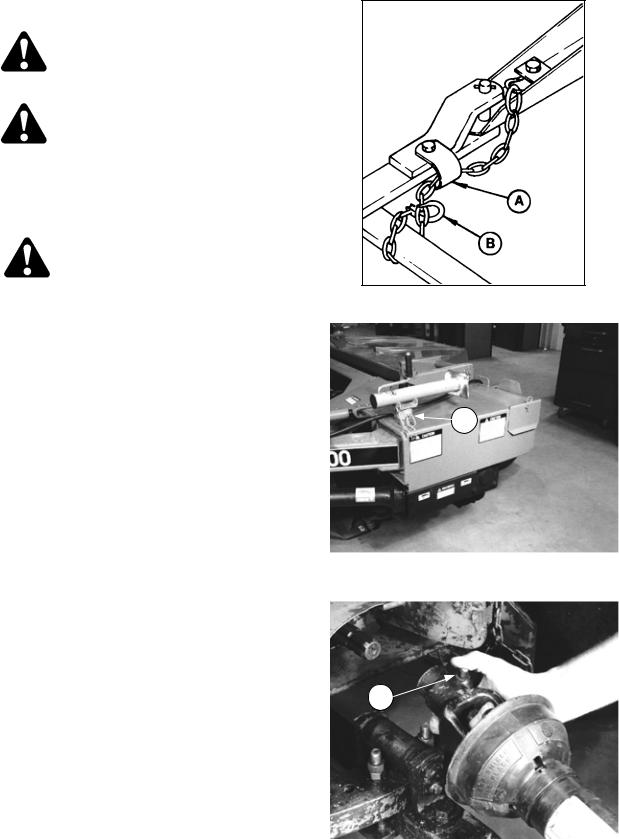
OPERATION
ATTACHING MOWER CONDITIONER TO TRACTOR
CAUTION: Shut off tractor, engage parking brake and remove key before working around hitch.
CAUTION: Never attach mower hitch to tractor rear axle or three-point hitch arms.
1.Attach mower conditioner to tractor drawbar with a 3/4 to 1 inch diameter hitch pin and secure with a spring locking pin or other suitable fastener.
CAUTION: To prevent damage to driveline guards, use a drawbar hitch pin with a low head.
2.Route hitch chain from mower conditioner through chain support (A), around drawbar support and lock hook (B) on chain.
IMPORTANT: Adjust chain length to remove all slack except what is needed for turns.
3.Remove weight from jack. Pull pin securing jack and move to storage position (C) on drives frame.
4.Push button (D) on telescoping driveline yoke and slide yoke onto tractor PTO shaft. Be sure yoke locks in position on shaft.
5.Connect hydraulic hoses to the remote cylinder control valves on tractor.
6.Connect mower conditioner wiring harness plug to outlet on tractor.
INSTALL HITCH PIN AND CHAIN
C
JACK STORAGE
D
ATTACH DRIVELINE TO PTO
16

OPERATION
DETACHING MOWER CONDITIONER FROM TRACTOR
CAUTION: To prevent accidental movement of tractor, shut off engine, engage parking brake, and remove key.
To maintain stability, always lower the machine completely. Block mower conditioner wheels before detaching from tractor.
Park machine on flat level surface.
Move remote cylinder control valve lever back and forth to relieve stored hydraulic pressure.
1.Pull pin securing jack and move to working position (A).
2.Lower jack to take weight off tractor drawbar.
3.Push button on telescoping driveline yoke to unlock grip on PTO shaft. Remove driveline from PTO and store in support (B).
4.Disconnect hydraulic hoses and electrical harness. Store so ends are off ground.
5.Remove hitch pin (C) and unhook chain (D) from tractor. Wrap chain around mower conditioner hitch for storage.
6.Slowly drive tractor away from mower conditioner.
A
MOVE JACK TO WORKING POSITION
B
STORE DRIVELINE
REMOVE HITCH PIN AND CHAIN
17

OPERATION
BREAK-IN PERIOD
1.After attaching mower conditioner to tractor for the first time, operate the machine slowly for 5 minutes, watching and listening FROM THE TRACTOR SEAT for binding or interfering parts.
CAUTION: Before investigating an unusual sound or attempting to correct a problem, shut off tractor, engage parking brake and remove key.
2.Check both belts (A) after 5 hours operation for initial stretch. Tighten as necessary. (See Maintenance/Service section). Continue to check the belts periodically for the first 50 hours.
3.Check hardware after 5 hours operation. Tighten as necessary. See Specifications section for recommended torques.
4.Check wheel bolt torque after 10 hours operation and periodically thereafter (at least every 100 hours).
Torque: 50 to 60 ft. lbs. (68 to 81 N m)
5.Tighten the four wobble box mounting bolts (B)
after 10 hours operation and every 100 hours thereafter. Torque to 200 ft. lbs. (270 N m), starting with the side mounting bolts.
6.Check reel drive chain (C) after 10 hours operation for proper tension. See Maintenance/Service section.
7.Change wobble box lubricant after 50 hours operation and every 1000 hours (or 3 years) thereafter. See Maintenance/Service section.
8.Until you become familiar with the sound and feel of your new mower conditioner, be extra alert and attentive.
A
CHECK BELT TENSION
B
CHECK WOBBLE BOX MOUNTING BOLTS
C
CHECK REEL DRIVE CHAIN TENSION
18

OPERATION
PRE-STARTING CHECKS
Do the following at the start of each operating season:
CAUTION:
1.Review the Operator’s Manual to refresh your memory on safety and operating recommendations.
2.Review all safety signs and other decals on the mower conditioner and note hazard areas.
3.Be sure all shields and guards are properly installed and secured. Never alter or remove safety equipment.
4.Be sure you understand and have practiced safe use of all controls. Know the capacity and operating characteristics of the machine.
5.Check the first aid kit and fire extinguisher. Know where they are and how to use them.
Also:
6.Adjust tension on drive belts. See Maintenance/Service section.
7.Perform all Annual maintenance. See Maintenance/Service section.
19

OPERATION
PRE-STARTING CHECKS
Do the following each day before start-up:
CAUTION:
1.Clear the area of other persons, pets etc. Keep children away from machinery. Walk around the windrower to be sure no one is under, on or close to it.
2.Remove foreign objects from the machine and surrounding area.
3.Wear close fitting clothing and protective shoes with slip resistant soles.
As well, carry with you any protective clothing and personal safety devices that COULD be necessary through the day. Don’t take chances.
You may need:
-a hard hat
-protective glasses or goggles
-heavy gloves
-respirator or filter mask
-wet weather gear.
4.Protect against noise. Wear a suitable hearing protective device such as earmuffs or earplugs to protect against objectionable or uncomfortable loud noises.
5.Check the machine for leaks or any parts that are missing, broken, or not working correctly.
NOTE: Use proper procedure when searching for pressurized fluid leaks. See "Hydraulics" in Maintenance/Service section.
6.Be sure tractor and windrower are properly attached, all controls are in neutral and tractor brake is engaged.
7.Clean all lights and reflective surfaces on the machine. Check lights for proper operation.
8.Perform all Daily maintenance. See Maintenance/Service section.
PROTECT YOURSELF
PROTECT AGAINST NOISE
20

OPERATION
OPERATE CORRECTLY
CAUTION:
1.Follow all safety and operational instructions given in your tractor Operator’s Manual. If you do not have a tractor manual, get one from your dealer and read it thoroughly.
2.Never attempt to start the tractor engine or operate the mower conditioner except from the tractor seat.
3.Check the operation of all controls in a safe clear area before starting work.
4.Do not allow riders on tractor or mower conditioner.
5.Never start or move the machine until you are sure all bystanders have cleared the area.
6.Avoid travelling over loose fill, rocks, ditches or holes.
7.Drive slowly through gates and doorways.
8.If mowing ditch banks, use extreme caution. If the mower conditioner hits an obstruction, the front of the tractor will usually swerve towards the ditch.
9.When working on inclines, travel uphill or downhill when possible. Be sure to keep tractor transmission in gear when travelling downhill.
10.Never attempt to get on or off a moving tractor.
11.Do not get off the tractor while the mower conditioner is in operation.
12.Stop tractor engine and remove key before adjusting or removing plugged material from the machine. A child or even a pet could engage the drive.
13.Check for excessive vibration and unusual noises. If there is any indication of trouble, shut down and inspect the machine. Follow proper shutdown procedure:
-engage tractor brake
-disengage PTO
-turn off engine and remove key
-wait for all movement to stop
-dismount and engage cylinder stop before inspecting raised machine.
14.Operate only in daylight or good artificial light.
IMPORTANT: Correct operation reduces crop loss and allows cutting of more acres. The length of service you receive from your mower conditioner depends upon timely maintenance and proper adjustments. Satisfactory function of this machine in all crop conditions requires making proper adjustments to suit various conditions.
21
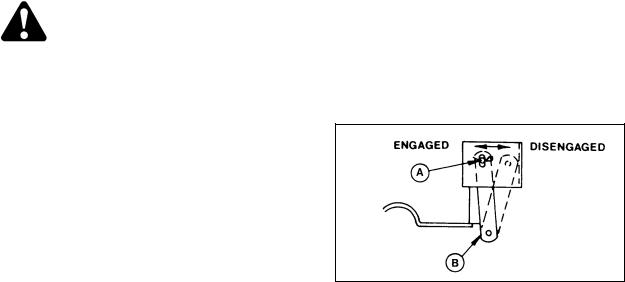
OPERATION
LIFT CYLINDER STOP
(RAISING AND LOWERING MOWER CONDITIONER)
WARNING: To avoid bodily injury or death from fall of raised machine, always engage lift cylinder stop before going under mower conditioner for any reason.
To engage cylinder stops:
1.Raise machine to maximum height by activating remote cylinder control valve in tractor.
2.Remove pin (A) and move support (B) forward, aligning hole in support with slot in frame lug.
3.Replace pin (A) to secure the support in the engaged position.
4.Lower machine slightly so support takes some
weight. |
LIFT CYLINDER STOP |
To lower mower conditioner:
1.Raise machine to maximum height to take weight off support (B).
2.Remove pin (A) and move support back to disengaged position.
3.Replace pin (A) to secure the support in disengaged position.
4.Lower machine by activating remote cylinder control valve in tractor.
22
